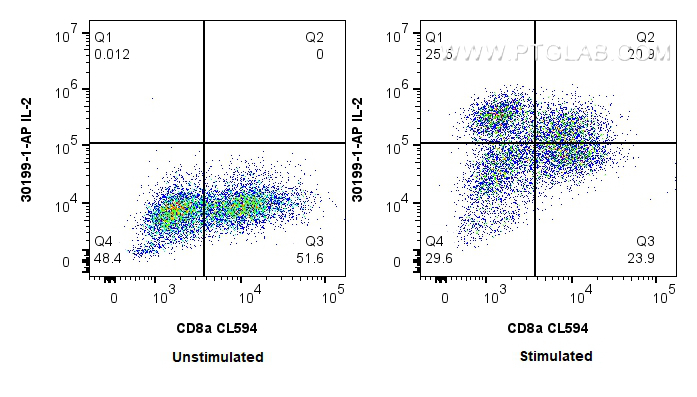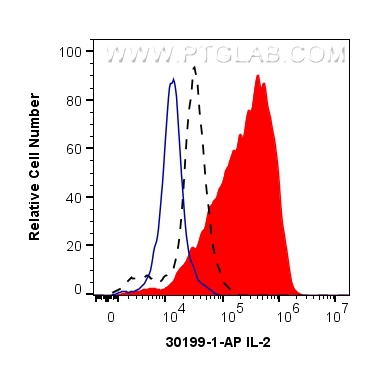验证数据展示
经过测试的应用
| Positive FC (Intra) detected in | PMA and ionomycin treated rat splenocytes cells |
推荐稀释比
| 应用 | 推荐稀释比 |
|---|---|
| Flow Cytometry (FC) (INTRA) | FC (INTRA) : 0.50 ug per 10^6 cells in a 100 µl suspension |
| It is recommended that this reagent should be titrated in each testing system to obtain optimal results. | |
| Sample-dependent, Check data in validation data gallery. | |
产品信息
30199-1-AP targets IL-2 in FC (Intra), ELISA applications and shows reactivity with rat samples.
| 经测试应用 | FC (Intra), ELISA Application Description |
| 经测试反应性 | rat |
| 免疫原 |
CatNo: Eg0260 Product name: Recombinant Rat IL-2 protein (His Tag) Source: mammalian cells-derived, pHZ-KIsec-C-6*HIS Tag: C-6*HIS Domain: 21-155 aa of NM_053836 Sequence: MAPTSSPAKETQQHLEQLLLDLQVLLRGIDNYKNLKLPMMLTFKFYLPKQATELKHLQCLENELGALQRVLDLTQSKSFHLEDAGNFISNIRVTVVKLKGSENKFECQFDDEPATVVEFLRRWIAICQSIISTMTQ 种属同源性预测 |
| 宿主/亚型 | Rabbit / IgG |
| 抗体类别 | Polyclonal |
| 产品类型 | Antibody |
| 全称 | interleukin 2 |
| 别名 | Il2, interleukin 2 |
| 计算分子量 | 18 kDa |
| GenBank蛋白编号 | NM_053836 |
| 基因名称 | Il2 |
| Gene ID (NCBI) | 116562 |
| RRID | AB_3086260 |
| 偶联类型 | Unconjugated |
| 形式 | Liquid |
| 纯化方式 | Antigen affinity purification |
| UNIPROT ID | P17108 |
| 储存缓冲液 | PBS with 0.02% sodium azide and 50% glycerol, pH 7.3. |
| 储存条件 | Store at -20°C. Stable for one year after shipment. Aliquoting is unnecessary for -20oC storage. |
背景介绍
IL2 is a secreted cytokine involved in the operation and regulation of immune system. IL2 plays a pivotal role in T-cell activation and effector functions, including T cell proliferation, interferon-γproduction and cytotoxicity. IL2 can stimulate the propagation of lymphocytes and induce the cytotoxic T lymphocytes and lymphokine-activated killer cells for tumor cells. IL2 also influences memory T cell homeostasis through the regulation of memory T cell numbers and enhances major histocompatibility complex II (MHC II) expression on tumor cells.
实验方案
| Product Specific Protocols | |
|---|---|
| FC protocol for IL-2 antibody 30199-1-AP | Download protocol |
| Standard Protocols | |
|---|---|
| Click here to view our Standard Protocols |



